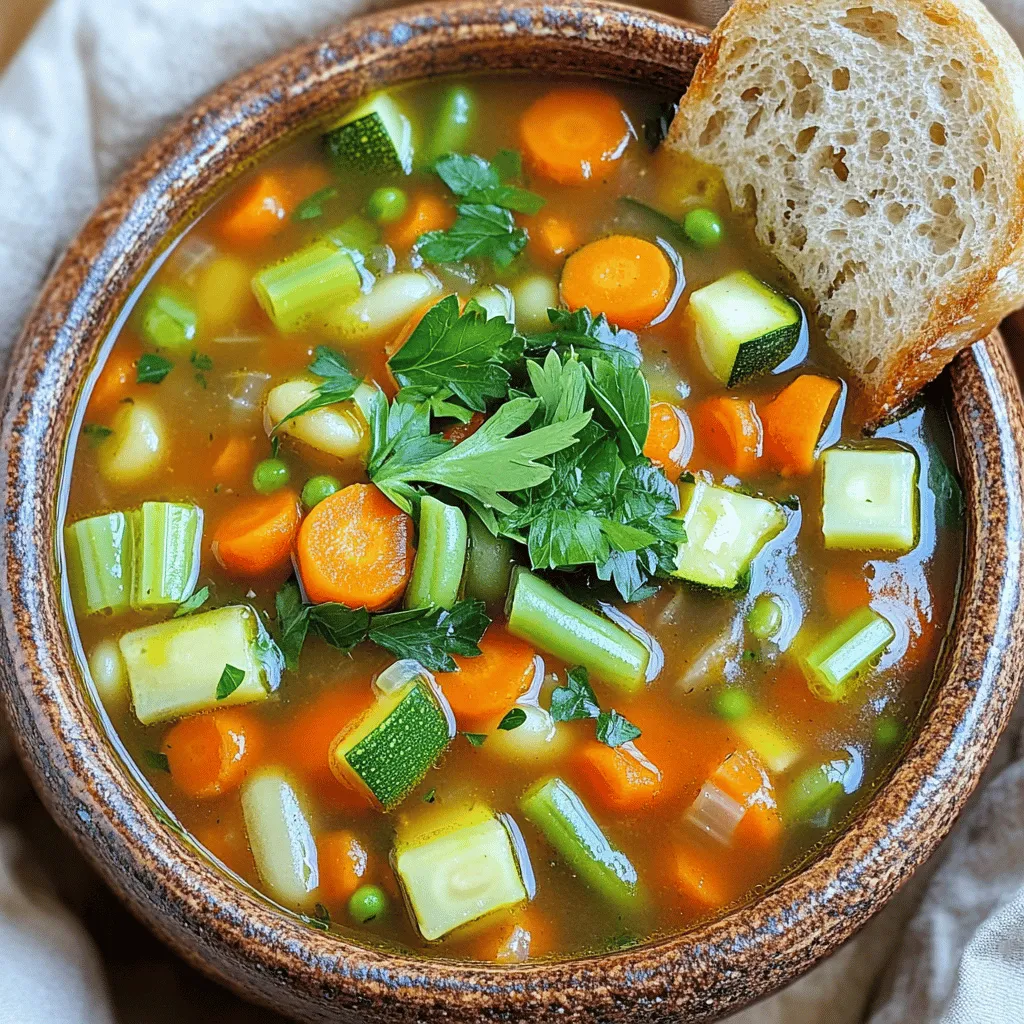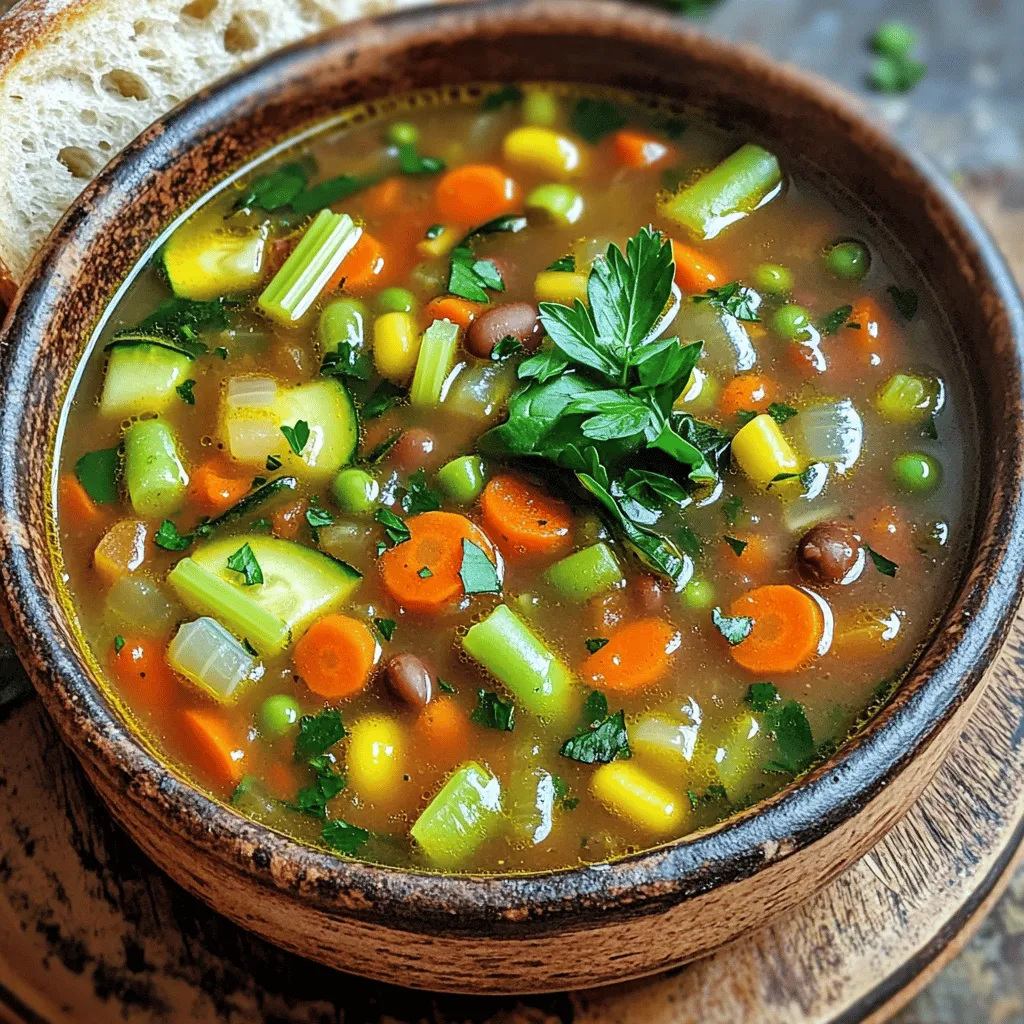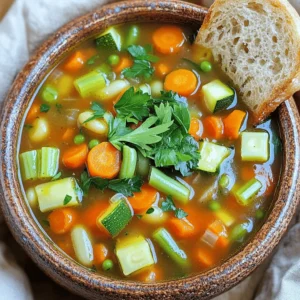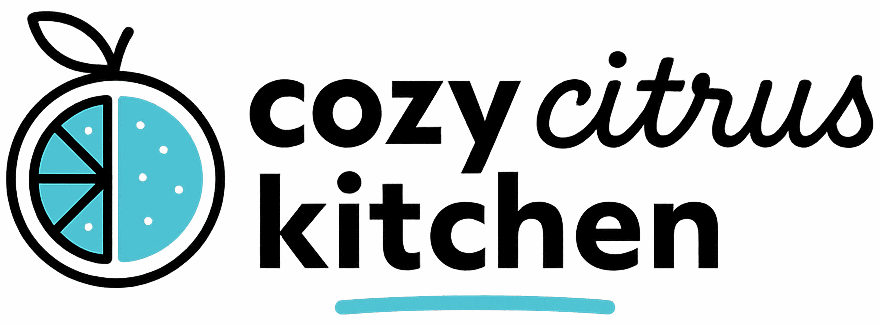If you’re looking for a warm and filling meal, try my Veggie Packed Minestrone. It’s not just a soup; it’s a bowl brimming with tasty vegetables and hearty pasta. This recipe is easy to make and loaded with nutrients. You’ll want to keep coming back for seconds! Let’s dive into the fresh ingredients and simple steps to create this healthy dish that the whole family will love.

Ingredients
List of Ingredients for Veggie Packed Minestrone
For a delightful bowl of Veggie Packed Minestrone, gather these fresh ingredients:
– 1 tablespoon olive oil
– 1 medium onion, diced
– 2 cloves garlic, minced
– 2 carrots, diced
– 2 celery stalks, diced
– 1 medium zucchini, diced
– 1 cup green beans, chopped
– 1 can (14 oz) diced tomatoes, with juices
– 4 cups vegetable broth
– 1 can (15 oz) kidney beans, rinsed and drained
– 1 cup uncooked pasta (such as ditalini or penne)
– 1 teaspoon dried oregano
– 1 teaspoon dried basil
– 1 bay leaf
– Salt and pepper, to taste
– 2 cups baby spinach or kale
– Fresh parsley or basil for garnish
Substitutions for Common Ingredients
You can swap ingredients based on what you have. Here are some easy swaps:
– Olive oil: Use avocado oil or coconut oil.
– Vegetable broth: Chicken broth works well too.
– Kidney beans: Any canned beans like cannellini or black beans are great.
– Pasta: Use gluten-free pasta if needed.
– Spinach or kale: Try Swiss chard or arugula for a twist.
Nutritional Benefits of the Ingredients
This soup is not just tasty; it’s also packed with health benefits:
– Olive oil: Rich in healthy fats and good for your heart.
– Vegetables: High in vitamins, minerals, and fiber for digestion.
– Kidney beans: Great source of protein and iron.
– Spinach or kale: Loaded with antioxidants and helps with bone health.
– Tomatoes: Provide lycopene, which is good for your skin and heart.
With these ingredients, you create a warm, filling soup that nourishes both body and soul. Enjoy every hearty spoonful of this veggie-packed delight!
Step-by-Step Instructions
Detailed Cooking Steps
1. Heat the Olive Oil: Start by pouring one tablespoon of olive oil into a large pot. Turn the heat to medium.
2. Sauté the Onion: Add the diced onion. Cook for about 3-4 minutes. The onion should look translucent.
3. Add Garlic: Stir in two minced garlic cloves. Cook for another minute until you smell the garlic.
4. Mix in Carrots and Celery: Add two diced carrots and two diced celery stalks. Sauté for another 5 minutes until they start to soften.
5. Incorporate Zucchini and Green Beans: Toss in the diced zucchini and chopped green beans. Sauté for an additional 3-4 minutes.
6. Pour in Tomatoes and Broth: Add one can of diced tomatoes, juices included, along with four cups of vegetable broth. Stir until mixed well.
7. Season the Soup: Add the rinsed kidney beans, one teaspoon each of dried oregano and basil, a bay leaf, salt, and pepper. Bring the soup to a boil.
8. Simmer the Soup: Lower the heat and let it simmer for about 15 minutes. This helps the flavors mix.
9. Cook the Pasta: Stir in one cup of uncooked pasta. Follow the package instructions, usually around 7-10 minutes, until it is al dente.
10. Add Greens: In the last minute, stir in two cups of baby spinach or kale. This helps them wilt nicely.
11. Finish Up: Remove the bay leaf. Taste the soup and adjust the seasoning if needed.
Cooking Tips for Better Flavor
– Use fresh herbs like parsley or basil for garnish. This elevates the taste and looks great!
– Sauté the vegetables until they are soft but not mushy. This keeps the soup hearty.
– Don’t rush the simmering stage. Letting the soup cook longer helps the flavors blend better.
How to Ensure Perfect Pasta Texture
– Add the pasta toward the end of cooking. This prevents it from getting too soft.
– Check the pasta a minute before the time on the package. It should be firm but cooked through.
– If you have leftovers, store the pasta separately. This keeps it from soaking up too much broth.
Tips & Tricks
Best Practices for Cooking Minestrone
To make a great minestrone, start with fresh veggies. Fresh produce gives your soup better taste. Dice the onion small for even cooking. Sauté it until it looks clear, about 3-4 minutes. This step builds a nice base for your soup. Always add garlic after the onion. Cook it for just one minute to avoid burning.
When adding vegetables, think about their cooking times. Carrots and celery need more time to soften. Add them first, then add softer veggies like zucchini and green beans later. This way, every bite is perfect.
Enhancing the Flavor Profile
To boost flavors, use dried herbs like oregano and basil. They add depth and warmth. Make sure to add them early in the cooking process. The longer they cook, the more flavor they release.
Don’t forget about salt and pepper. Season as you go. This helps build layers of taste. A bay leaf adds a subtle aroma. Just remember to take it out before serving!
Making Your Soup Heartier
If you want a heartier soup, you can add more beans or pasta. Kidney beans are great, but chickpeas or lentils work too. They add protein and fiber, making your meal more filling.
Another tip is to add more broth. This keeps the soup rich and flavorful. If you want extra greens, toss in some kale or spinach at the end. They’ll wilt right into the soup and give it a nice color.
These tips can help you create a delicious, veggie-packed minestrone that warms your soul!

Variations
Different Vegetable Options
You can swap or add many veggies to your minestrone. Try sweet bell peppers for a pop of color. Corn adds sweetness and crunch. You can also use butternut squash for a creamy texture. Broccoli and cauliflower bring a nice bite. Don’t forget leafy greens like Swiss chard or collard greens. The more colors, the better your soup will look and taste.
Protein Additions for Extra Nutrients
To boost protein, add cooked chicken, turkey, or sausage. Lentils or chickpeas also work well and keep it plant-based. For a heartier soup, toss in cubed tofu or tempeh. These options will keep you full and add a new flavor twist. They can also help round out your meal and make it more satisfying.
Dietary Adaptations (Vegan, Gluten-Free, etc.)
You can easily adapt this soup for different diets. For a vegan option, just use vegetable broth and skip any meat. To make it gluten-free, choose gluten-free pasta. You can also use rice or quinoa as a base. These small changes let everyone enjoy this tasty soup. Always check labels for hidden gluten in canned goods.
Storage Info
Proper Storage Techniques
To keep your veggie packed minestrone fresh, let it cool first. Pour the soup into an airtight container. Make sure to seal it well. Place it in the fridge if you plan to eat it within three days. If you need it longer, consider freezing it.
Reheating Recommendations
When you are ready to enjoy your soup, heat it on the stove. Start with medium heat and stir often. If you find it too thick, add a little water or broth. You can also microwave it in a bowl. Cover the bowl to avoid spills and heat in short bursts.
Freezing Soup for Later Use
To freeze your minestrone, use freezer-safe containers or bags. Leave some space at the top of the container. This allows for expansion as it freezes. Label the container with the date. It will keep well for up to three months. When you’re ready to eat it, thaw it in the fridge overnight. Then reheat it as mentioned above.
FAQs
How do I make Veggie Packed Minestrone richer?
To make your Veggie Packed Minestrone richer, add more broth or a splash of wine. You can also stir in some grated cheese like Parmesan. This adds depth and a nice salty flavor. Using fresh herbs, like basil or parsley, can boost the taste too. Try adding a tablespoon of pesto for a burst of flavor. It enhances the soup and makes it creamier.
Can I use fresh vegetables instead of canned?
Yes, you can use fresh vegetables instead of canned ones! Fresh veggies add a vibrant taste and texture. Dice up fresh tomatoes instead of canned ones. Use fresh green beans and zucchini for crunch. Just make sure to adjust cooking times. Fresh veggies may take a bit longer to soften. Always taste as you go to find the perfect texture.
How do I know when the pasta is done in the soup?
To know when the pasta is done, taste it for doneness. You want it to be al dente, meaning it has a slight bite. Check the package directions for cooking time. Usually, it cooks in about 7-10 minutes. Make sure to stir it occasionally to prevent sticking. If you notice it getting too soft, remove the pot from heat right away.
This blog post covered how to make a delicious veggie-packed minestrone soup. We discussed the ingredients, their benefits, and tips for better flavor. You learned how to cook your pasta just right. I shared variations for more nutrients and dietary needs.
In closing, minestrone is not just good for you; it’s fun to make. Enjoy experimenting with flavors and textures to create your perfect bowl.

